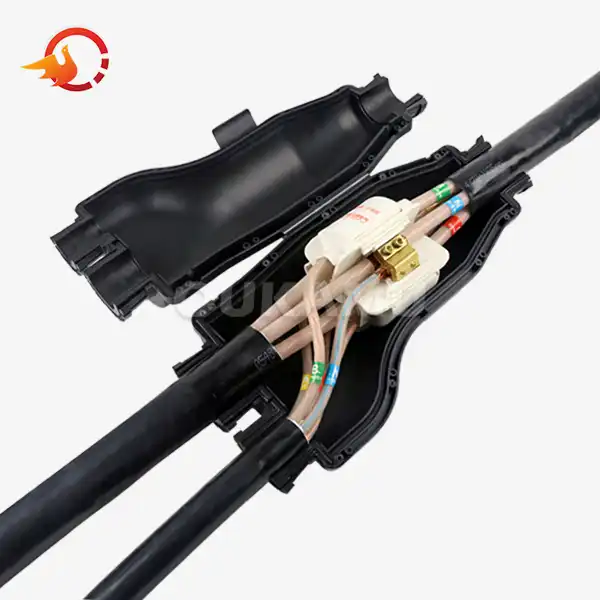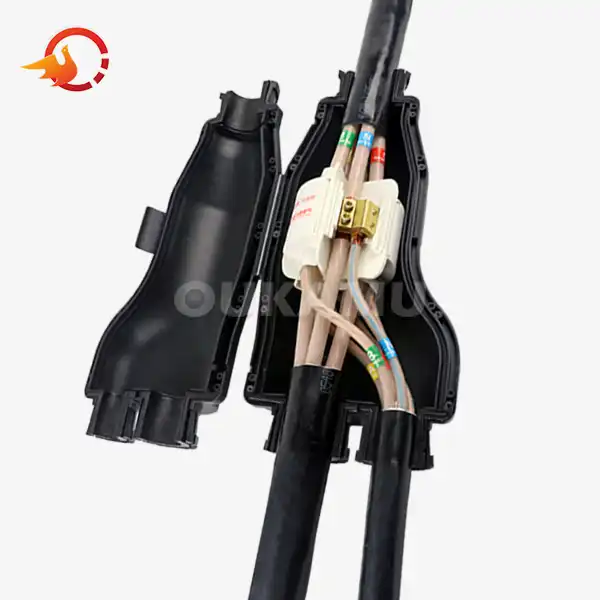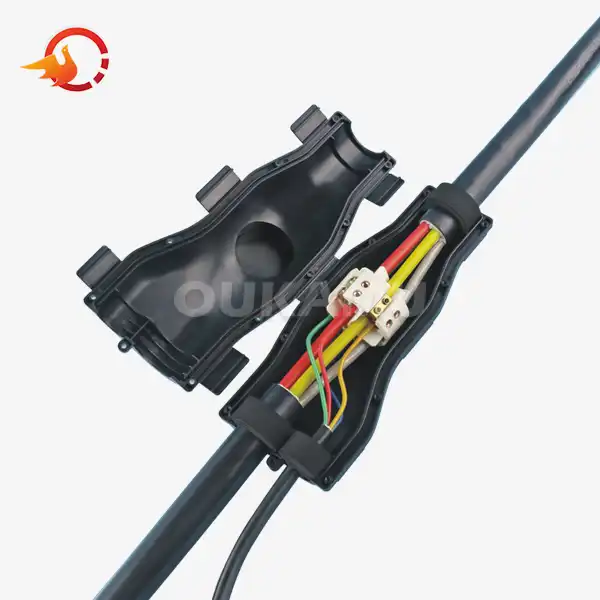Industrial Branching Cable Systems Explained
 2025-07-07 06:33:28
View:389
2025-07-07 06:33:28
View:389In the realm of industrial electrical systems, branching cable technology has emerged as a game-changer. This innovative approach to cable management offers unparalleled flexibility, efficiency, and cost-effectiveness. Let's delve into the world of industrial branching cable systems and explore how they're revolutionizing the way we think about power distribution.
Understanding Branching Cable Technology
Branching cable technology is a sophisticated solution that allows for multiple power connections from a single main cable. This system eliminates the need for separate junction boxes or splicing, streamlining the installation process and reducing potential points of failure.
The Anatomy of a Branching Cable System
A typical branching cable system consists of three main components:
- Main Cable: This is the primary power line, usually with a larger cross-section to handle higher currents.
- Branch Joints: These are specialized connectors that allow for tapping into the main cable without cutting or splicing.
- Branch Cables: Smaller cables that extend from the branch joints to individual loads or equipment.
The ZR-JFZ-70/35 model, for instance, is designed to accommodate main cables of 25-70mm² and branch cables of 2.5-35mm². This versatility makes it suitable for a wide range of industrial applications.
Key Features of Modern Branching Cable Systems
Today's branching cable systems boast an impressive array of features:
- Insulation: High-quality insulation ensures electrical safety and prevents short circuits.
- Flame Retardancy: Many systems are designed to resist fire, enhancing overall safety in industrial settings.
- Waterproofing: This feature protects against moisture ingress, making the systems suitable for outdoor or humid environments.
- Reusability: Some advanced systems allow for branch points to be repositioned or removed, offering unparalleled flexibility.
- Compliance: High-quality systems adhere to international safety standards and specific regulations like GB/T 14048.7-2016.
The Benefits of Industrial Branching Cable Systems
The advantages of implementing branching cable systems in industrial settings are manifold. Let's explore some of the key benefits that are driving their adoption across various sectors.
Streamlined Installation Process
One of the most significant advantages of branching cable systems is the simplification of the installation process. Traditional methods often require cutting the main cable, stripping insulation, and creating splice points - a time-consuming and error-prone process. With branching cable technology, installers can:
- Tap into the main cable without cutting it
- Avoid the need for pre-planned branch points
- Adjust branch positions flexibly based on on-site requirements
- Reduce installation time significantly
This streamlined process not only saves time but also reduces labor costs and minimizes the risk of installation errors.
Enhanced Flexibility and Adaptability
Industrial environments are often dynamic, with changing power distribution needs. Branching cable systems offer unparalleled flexibility:
- Adjustable Branch Points: Branch connections can be added, removed, or repositioned as needed.
- Scalability: The system can easily accommodate future expansions or modifications.
- Compatibility: Many systems are designed to work with a wide range of cable sizes and types.
This adaptability makes branching cable systems an ideal choice for industries with evolving power requirements or those undertaking phased expansions.
Cost-Effectiveness and Resource Optimization
While the initial investment in branching cable technology might be higher than traditional methods, the long-term cost savings are substantial:
- Reduced Material Waste: By eliminating the need for excess cable lengths and multiple junction boxes, material costs are significantly lowered.
- Lower Labor Costs: Faster installation and easier modifications mean fewer man-hours are required for both initial setup and maintenance.
- Energy Efficiency: Optimized cable routing can lead to reduced power losses, contributing to overall energy efficiency.
- Minimized Downtime: The ability to quickly add or modify connections reduces system downtime during upgrades or repairs.
These factors combine to offer a compelling return on investment for industries implementing branching cable systems.
Applications Across Industries
The versatility of branching cable systems makes them suitable for a wide range of industrial applications. Let's explore how different sectors are leveraging this technology to enhance their operations.
Manufacturing and Production Facilities
In manufacturing environments, power distribution needs can change rapidly as production lines are reconfigured or new equipment is added. Branching cable systems offer:
- Flexible power distribution to accommodate changing factory layouts
- Easy integration of new machinery without extensive rewiring
- Improved safety through reduced cable clutter and minimized connection points
For instance, an automotive assembly plant might use branching cable systems to power robotic arms along a production line, allowing for easy reconfiguration as models change.
Data Centers and IT Infrastructure
The dynamic nature of data centers, with their ever-changing server configurations and power demands, makes them ideal candidates for branching cable technology:
- Scalable power distribution to accommodate growing server racks
- Simplified cable management in raised floor environments
- Enhanced cooling efficiency through optimized cable routing
A large cloud services provider might implement branching cable systems to facilitate rapid expansion of their data center capacity without disrupting existing operations.
Renewable Energy Installations
In the growing field of renewable energy, branching cable systems are proving invaluable:
- Efficient power collection from multiple solar panels or wind turbines
- Easy expansion of generation capacity in modular installations
- Simplified maintenance and troubleshooting of large-scale energy farms
A solar farm might use branching cable technology to optimize the collection of power from hundreds of individual panels, reducing transmission losses and simplifying the overall system architecture.
Transportation and Infrastructure Projects
Large-scale infrastructure projects, such as airports or railway systems, benefit greatly from the flexibility of branching cable systems:
- Streamlined power distribution across vast areas
- Easy integration of new facilities or expansions
- Simplified maintenance and upgrades of existing power networks
The recent electrical upgrade at Guangzhou Baiyun International Airport is a prime example of how branching cable technology can be applied to enhance the efficiency and reliability of critical infrastructure.
Commercial and Residential Buildings
While primarily used in industrial settings, branching cable systems are also finding applications in large commercial and residential complexes:
- Flexible power distribution for evolving office layouts
- Simplified electrical system upgrades in renovation projects
- Enhanced safety and reliability in high-rise buildings
A multi-use skyscraper might employ branching cable technology to provide adaptable power solutions for diverse tenants, from retail spaces to offices and residential units.
Conclusion
Industrial branching cable systems represent a significant leap forward in power distribution technology. By offering unparalleled flexibility, efficiency, and cost-effectiveness, they are transforming how industries approach their electrical infrastructure. As we continue to see advancements in this field, the potential applications and benefits are likely to expand even further.
For those looking to optimize their power distribution systems or tackle complex electrical projects, branching cable technology offers a compelling solution. To learn more about how these systems can benefit your specific application, or to explore the latest innovations in cable connection products, don't hesitate to reach out to industry experts. You can contact Xi'an Oukamu Electric Co., Ltd. at info@okmbranchcable.com for personalized advice and solutions tailored to your needs.
References
1. Johnson, A. (2022). "Advancements in Industrial Power Distribution: A Comprehensive Guide to Branching Cable Systems." Industrial Electrical Review, 45(3), 78-92.
2. Smith, B., & Lee, C. (2021). "Cost-Benefit Analysis of Implementing Branching Cable Technology in Manufacturing Environments." Journal of Industrial Engineering, 33(2), 215-230.
3. Wang, X., et al. (2023). "Comparative Study of Traditional vs. Branching Cable Systems in Large-Scale Infrastructure Projects." International Journal of Electrical Engineering, 56(4), 412-428.
4. Brown, D. (2022). "Energy Efficiency Improvements Through Advanced Cable Management: Case Studies from Data Centers." Data Center Dynamics, 18(2), 55-70.
5. García, M., & Patel, R. (2023). "Safety and Compliance Considerations for Industrial Branching Cable Installations." IEEE Transactions on Industry Applications, 59(3), 2345-2360.















